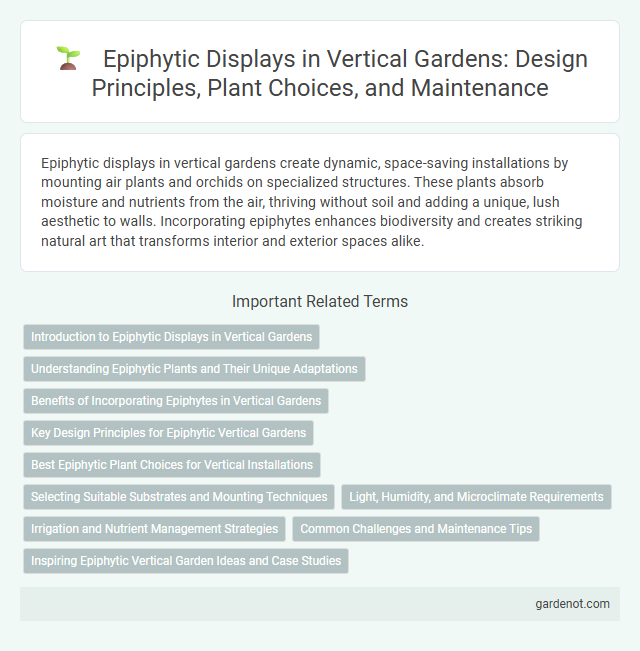Epiphytic displays in vertical gardens create dynamic, space-saving installations by mounting air plants and orchids on specialized structures. These plants absorb moisture and nutrients from the air, thriving without soil and adding a unique, lush aesthetic to walls. Incorporating epiphytes enhances biodiversity and creates striking natural art that transforms interior and exterior spaces alike.
Introduction to Epiphytic Displays in Vertical Gardens
Epiphytic displays in vertical gardens utilize plants that grow on other surfaces without soil, such as orchids, bromeliads, and ferns. These plants absorb moisture and nutrients from the air, making them ideal for creating lightweight, low-maintenance vertical installations. Incorporating epiphytes enhances biodiversity and adds unique textural and visual interest to green walls.
Understanding Epiphytic Plants and Their Unique Adaptations
Epiphytic plants thrive in vertical garden displays by growing on other plants or structures without extracting nutrients from their hosts, showcasing unique adaptations such as aerial roots that absorb moisture and nutrients from the air. Their specialized ability to capture water and nutrients through trichomes and spongy roots allows them to survive in nutrient-poor environments. Understanding these adaptations is crucial for designing sustainable vertical gardens that mimic natural epiphytic habitats.
Benefits of Incorporating Epiphytes in Vertical Gardens
Incorporating epiphytes in vertical gardens maximizes space efficiency by utilizing plants that thrive without soil, allowing for lush, low-maintenance displays. These plants enhance indoor air quality by absorbing pollutants and increasing humidity levels, contributing to healthier living environments. Their unique growth habits create visually striking textures and patterns, promoting biodiversity and ecological balance in urban green spaces.
Key Design Principles for Epiphytic Vertical Gardens
Epiphytic vertical gardens thrive by optimizing air circulation and moisture retention through strategic plant spacing and the use of breathable, lightweight substrates like sphagnum moss or orchid bark. Effective support systems such as modular panels or wire frames ensure plants attach naturally without soil, mimicking their native habitats for healthy growth. Maintaining balanced humidity levels and indirect lighting replicates epiphytes' environmental needs, promoting vibrant foliage and robust root development.
Best Epiphytic Plant Choices for Vertical Installations
Orchid species such as Phalaenopsis and Dendrobium excel as epiphytic plants for vertical garden installations due to their air-loving roots and vibrant blooms. Tillandsia, commonly known as air plants, require minimal soil and thrive in mounted displays, making them ideal for space-saving vertical designs. Bromeliads also provide textural diversity and moisture retention, enhancing the aesthetic and ecological functionality of vertical epiphytic gardens.
Selecting Suitable Substrates and Mounting Techniques
Selecting suitable substrates for epiphytic displays involves using materials like coconut coir, sphagnum moss, or orchid bark that retain moisture while allowing airflow essential for plant health. Mounting techniques such as attaching plants onto wooden plaques, tree fern slabs, or wire frames provide stable support and replicate natural growing conditions. Secure mounting combined with appropriate substrates ensures optimal root anchorage and nutrient absorption for vertical garden success.
Light, Humidity, and Microclimate Requirements
Epiphytic displays thrive in vertical gardens by requiring bright, indirect light to mimic their natural canopy habitats and prevent leaf scorch. Maintaining high humidity levels between 60-80% supports their moisture absorption through aerial roots, essential for healthy growth. Creating a microclimate with consistent air circulation and stable temperatures around 65-75degF enhances nutrient uptake and reduces fungal risks, optimizing the epiphyte's overall vitality.
Irrigation and Nutrient Management Strategies
Epiphytic display systems in vertical gardens utilize specialized irrigation techniques like fine misting and drip lines to maintain optimal moisture levels without waterlogging the root zone. Nutrient management relies on balanced, slow-release fertilizers and foliar feeding to supply essential minerals directly to the leaves and aerial roots, enhancing plant health and growth. Integrating automated irrigation controllers with sensor-based monitoring ensures precise water and nutrient delivery, reducing waste and improving sustainability.
Common Challenges and Maintenance Tips
Epiphytic vertical gardens often face challenges such as limited nutrient availability, water retention issues, and susceptibility to pests like scale insects and mealybugs. Regular misting combined with the use of diluted, balanced liquid fertilizers supports healthy growth and helps maintain optimal moisture levels. Inspecting plants weekly and removing dead or damaged foliage prevents disease spread and ensures a thriving epiphytic display.
Inspiring Epiphytic Vertical Garden Ideas and Case Studies
Epiphytic vertical gardens utilize air plants like Tillandsia and orchids, which thrive without soil by absorbing moisture and nutrients from the air, making them perfect for innovative indoor and outdoor displays. Creative case studies highlight vertical installations in urban environments, showcasing how epiphytes enhance aesthetic appeal while improving air quality and requiring minimal maintenance. These inspiring designs demonstrate sustainable green walls that optimize space, promote biodiversity, and bring natural elements into confined areas.
Epiphytic display Infographic

 gardenot.com
gardenot.com